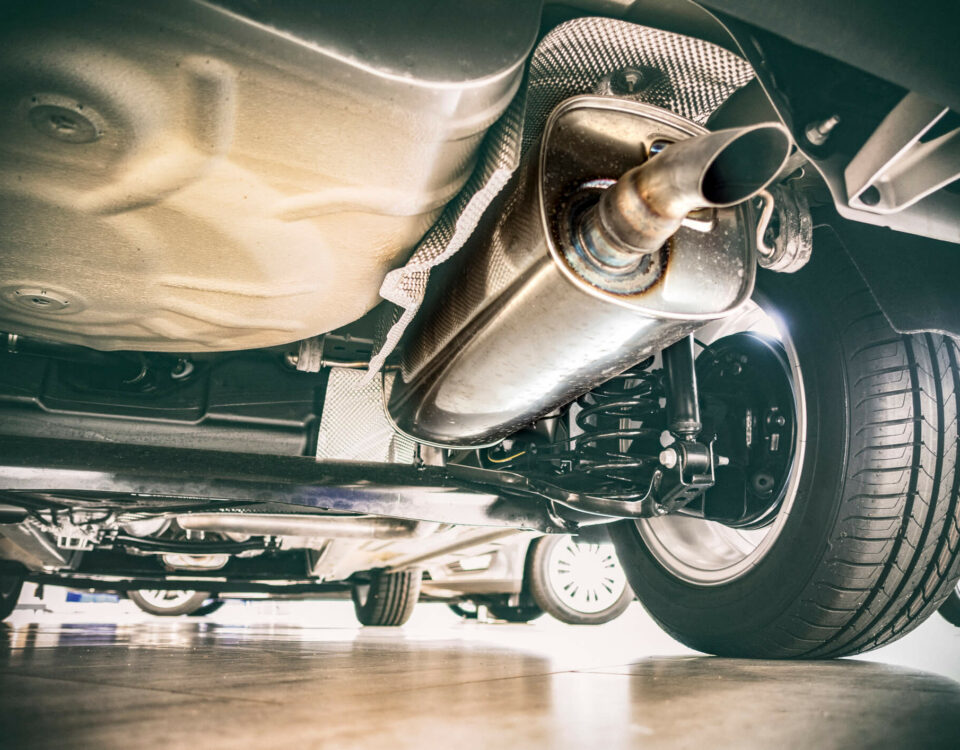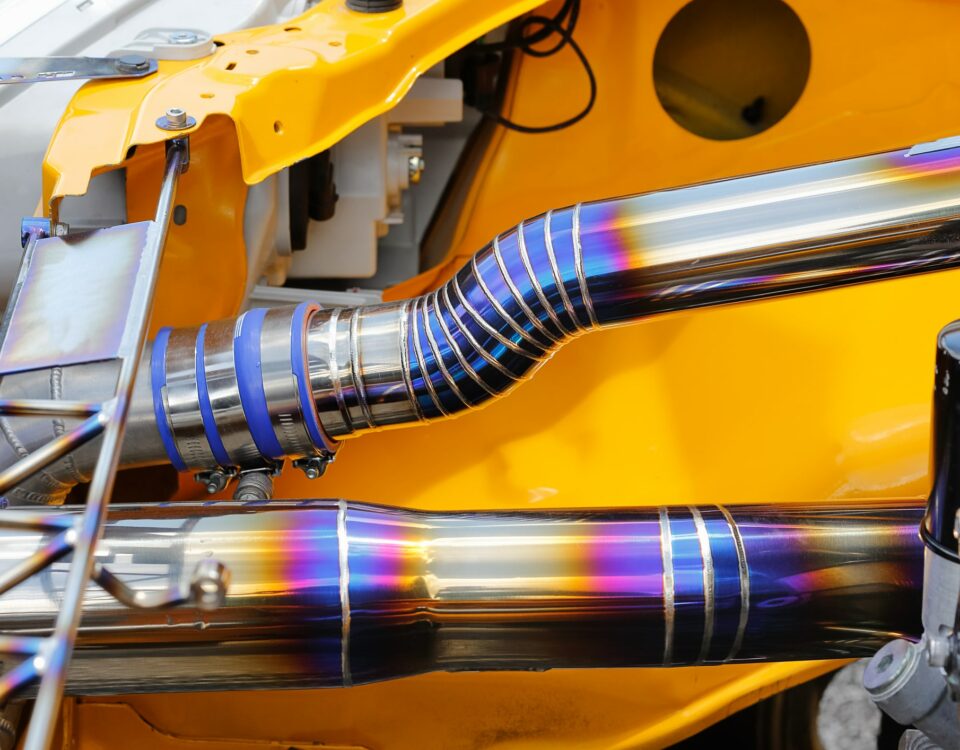What Are the Parts of An Exhaust System?
Your car’s engine constantly produces explosions (from combusting fuel) that rotate the crankshaft and power your vehicle, but this process also produces lots of waste products. Most of this waste is in the form of exhaust gases containing dangerous chemicals like nitrogen oxide, carbon monoxide, and hydrocarbons which must be carefully expelled from the vehicle.
To keep all those nasty exhaust gases from entering the car, engineers have developed various exhaust systems that channel the waste products from inside the engine to the outside of the car. Most modern exhaust systems are made from multiple components that can degrade or break over time, so we want to teach you all about your exhaust and how to detect faults before they become serious issues.
Importance Of Exhaust System in Your Car
Although it can seem like an afterthought, a functioning exhaust system is crucial for the operation of your engine. Whether you have an aluminium or stainless-steel exhaust, it is absolutely necessary to redirect toxic gases out of the vehicle and allow your engine to cycle, so you should know how to keep your exhaust in good working order.
How Does an Exhaust System Work?
As your engine runs, it generates exhaust gases which are directed into cylinder heads and exhaust manifolds, through exhaust pipes and ultimately outside of the car. The explosive force of combustion drives out exhaust gases, and they pass through the system, passing through filters and mufflers designed to limit noise and particle pollution depending on the type of vehicle.
On some types of vehicles – such as diesel cars – the exhaust system is fitted with a catalytic converter designed to eliminate harmful gases, which activates when the exhaust heats up enough. At the very end of the exhaust system, a muffler reduces noise levels by directing sound waves through a variety of pipes and holes, cancelling out a lot of the sound waves from your engine.
What Does a Full Exhaust System Include?
Before we take a detailed look at all components of your exhaust system, it helps to remember how many different parts make up this seemingly simple setup. So, to illustrate the inner workings of your car here’s a list of components you can expect to see in a full stainless-steel exhaust system:
- Catalytic converter
- Exhaust manifold
- Exhaust pipes
- Front muffler
- Front pipe
- Gaskets
- Rear muffler
- Heat shields
- Rear pipe
- Resonator
- Oxygen sensor
- Hangers
- Diesel particulate filter DPF (diesel cars)
- Tailpipe
What Are the Basic Parts of The Exhaust System?
While modern exhaust systems contain dozens of parts, many of these are (technically) nonessential or perform auxiliary duties, such as heat shields that help protect the underside of your car. Out of all the parts in your exhaust system, the following four are the most important:
1. Exhaust Manifold
First and foremost is the exhaust manifold: this part is attached to your engine block and directs the exhaust gases down the rest of your exhaust system. If your exhaust manifold is faulty or poorly fitted, some exhaust gases will escape, reducing back pressure, damaging engine performance and potentially causing an engine malfunction.
2. Oxygen Sensor
The oxygen sensor (or lambda sensor) is a small probe that measures the oxygen in your exhaust system and sends data to your ECU, helping to monitor and improve fuel efficiency. Most modern cars are fitted with two sensors – before and after the catalytic converter – to measure the levels of oxygen and pollutants after combustion and after being filtered through your catalytic converter.
3. Catalytic Convertor
Catalytic converters (or CATs for short) filter out pollutants and toxic chemicals from your exhaust gases by using rare metals like platinum and palladium in catalytic chemical reactions. Whether you have a stainless-steel exhaust system or not, Cats are one of the most vital parts of your exhaust, as they filter toxic chemicals from your exhaust gases, not to mention that they are required by law on all vehicles.
4. Muffler
Last but not least, mufflers are typically fitted near the end of exhaust systems and (you guessed it) muffle the noise of your engine to abide by noise restriction legislation. While they may look simple on the outside, mufflers use a precise configuration of pipes and baffles to create an echo chamber that cancels out sound waves rather than just filtering them out.
What Holds Up the Exhaust System?
Keeping an exhaust system in place is a tricky undertaking, as it can reach extremely high temperatures and constantly vibrates while in use, meaning you cannot just bolt it underneath your car. Therefore, exhaust supports (sometimes called hangers) are specially designed to dampen vibrations and hold your exhaust in place, with thick rubber straps and stainless-steel exhaust clamps to prevent any unwanted rattling or movement.
What Part of The Exhaust System Is a Catalytic Converter?
Generally speaking, catalytic converters resemble mufflers – but smaller and slimmer – and are fitted close to the engine, as they function better at high temperatures. Inside their unassuming casing, catalytic converters contain ceramic blocks or beads made up of thousands of tiny channels coated with precious metals like platinum.
When catalytic converters reach a high enough temperature, they catalyse chemical reactions in your exhaust gases, neutralising harmful chemicals by separating their molecules and burning off carbon. A well-designed catalytic converter can keep your exhaust clean for 10 years and up, but it can become clogged or faulty over time, so you should learn what to look out for.
What Are the Symptoms of a Failing Catalytic Converter?
Over time, catalytic converters can become clogged up with carbon deposits, overheat or suffer physical damage, restricting the flow of your exhaust system and affecting engine performance. If you think your cat might be acting up, you should look for symptoms of a failing catalytic converter and seek expert advice if you notice:
- Reduced acceleration
- Dark exhaust smoke
- Bad smell of sulphur coming from your exhaust system
- Overheated exhaust system due to failed oxygen sensor
- Coolant leaks due to faulty cylinder head.
All of these issues could indicate a serious mechanical problem or disaster waiting to happen, so make sure that you regularly maintain and service your car to keep it in good working order. Even if you have a brand-new car, your cat could be malfunctioning due to contamination or physical damage, so make sure to get it checked out before it grows into a bigger problem.
Keep Your Exhaust System Efficient
As the old saying goes, prevention is better than a cure. Fortunately, there are various ways to maintain your exhaust system, which range greatly in cost and convenience. To help keep your exhaust in working order for longer, consider the following factors and techniques:
- Wear and tear/Corrosion – rain, snow and grit can corrode your exhaust over time, so check for wear and tear more often if you drive through muddy/sandy areas often.
- Fuel Purity – Impurities in your fuel can clog up your exhaust and cat, reducing engine performance over time, so think about the higher octane options when you fill up next.
- Active regeneration – by driving at high speeds for longer periods, you can burn off carbon deposits in your catalytic filter, a process known as active regeneration.
- Carbon cleaning – many garages offer carbon cleaning services that clean your exhaust from the inside out, removing lots of impurities and carbon buildup.
Conclusion
Although it’s not the most exciting part of a car, your exhaust is crucial for preventing harmful gases from harming its occupants and the environment in general. It doesn’t take too much care, and attention so you can keep your exhaust in tip-top shape, so we hope that this article will help you care for your car’s exhaust and understand why it’s so essential to keep it working well.



